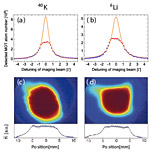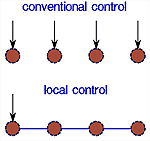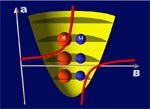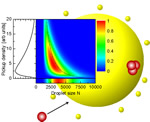EPJ D - Solitary waves induce waveguide that can split light beams
- Details
- Published on 10 August 2012

A Chinese team has performed simulations to help understand the occurrence of multiple solitary optical waves that are used to reconfigure optical beams.
Researchers have designed the first theoretical model that describes the occurrence of multiple solitary optical waves, referred to as dark photovoltaic spatial solitons.
EPJ D - Largest ever gas mix caught in ultra-freeze trap
- Details
- Published on 10 August 2012

Towards a better understanding of subatomic particles using a new cold-atom setup
A team of scientists have made it easier to study atomic or subatomic-scale properties of the building blocks of matter (which also include protons, neutrons and electrons) known as fermions by slowing down the movement of a large quantity of gaseous atoms at ultra-low temperature. This is according to a study recently published in EPJ D as part of a cold quantum matter special issue, by researchers from the Paris-based École Normale Supérieure and the Non-Linear Institute at Nice Sophia-Antipolis University in France.
EPJ D - Instant nanodots grow on silicon to form sensing array
- Details
- Published on 10 August 2012

New methods for creating 3D nanostructures deposited on an array of regularly spaced indentations on the surface of silicon films opens the door for innovative nanosensors
Scientists have shown that it is now possible to simultaneously create highly reproductive three-dimensional silicon oxide nanodots on micrometric scale silicon films in only a few seconds. Xavier Landreau and his colleagues at the University of Limoges, France, demonstrated in their paper published in EPJ D that they were able to create a square array of such nanodots, using regularly spaced nanoindents on the deposition layer, that could ultimately find applications as biosensors for genomics or bio-diagnostics.
EPJ D - Not one, not two, not three, but four clones!
- Details
- Published on 10 August 2012

First quantum cloning machine to produce four copies
Xi-Jun Ren and Yang Xiang from Henan Universities in China, in collaboration with Heng Fan at the Institute of Physics of the Chinese Academy of Sciences, have produced a theory for a quantum cloning machine able to produce several copies of the state of a particle at atomic or sub-atomic scale, or quantum state, in an article published in EPJ D. This could have implications for quantum information processing methods used, for example, in message encryption systems.EPJ D - Quantum teleportation analysed by mathematical separation tool
- Details
- Published on 15 September 2011

Scientists from the University of Vienna’s Faculty of Physics in Austria recently gave a theoretical description of teleportation phenomena in sub-atomic scale physical systems, in a publication in the European Physical Journal D.
For the first time, the Austrian team proved that mathematical tools give us the freedom to choose how to separate out the constituting matter of a complex physical system by selectively analysing its so-called quantum state. That is the state in which the system is found when performing measurement, which can either be entangled or not.
EPJ D - Speedier Quantum Logic
- Details
- Published on 16 May 2011

Quantum information processing requires logical operations with multiple quantum bits. One route to this goal is controlling each qubit with a time-dependent external magnetic field. In this recent paper published in EPJ D, Heule et al. describe ways to perform logical operations on an ENTIRE superconducting qubit chain by controlling just ONE of the end qubits of the chain.
EPJ D - 'Measurement of Quantum Mechanical Operators' Revisited
- Details
- Published on 31 March 2011
Quantum mechanical measurements are often assumed to be accurate and repeatable. However, due to a fundamental result of Wigner (1952) and Araki and Yanase (1961), we now know that there are limitations to these properties in the presence of aconserved quantity that does not commute with the observable to be measured. Despite its importance and impact on quantum technologies, the full scope of this so-called WAY theorem has remained unclear.
EPJ D - Feshbach resonances in the 6Li-40K Fermi-Fermi mixture: Elastic versus inelastic interactions
- Details
- Published on 30 March 2011

(Cold Quantum Matter - EuroQUAM special issue)
Ultracold mixtures of two fermionic species hold great promise for synthesizing novel types of few and many-body quantum states. Magnetically tunable Feshbach resonances are the key to controlling the interaction in such systems. In this article in EPJD, Naik et al. present a state-of-the-art characterization of Feshbach resonances in the Fermi-Fermi mixture of 6Li-40K atoms, in particular concerning the interplay of both elastic and inelastic scattering.
EPJ D – Nanodroplets make perfect hosts
- Details
- Published on 28 March 2011

Helium nanodroplets provide a unique matrix for the spectroscopy of embedded atom species. In this recent paper in EPJD, Bünermann and Stienkemeier demonstrate a new model of how effects such as droplet shrinking, momentum transfer and cluster desorption affect the pick-up statistics of alkali atoms in helium nanodroplets.
EPJ D - Reshaping Quantum Light
- Details
- Published on 03 January 2011

A photon is not a point: its wavepacket stretches out in space. In the classical limit, this spatial profile is governed by Maxwell's equations, and reshaping it has been a goal in optics since Galileo's invention of the telescope. In this paper, Morizur and his colleagues describe a new Unitary Programmable Mode Converter, a device capable of changing the spatial shape of quantum light at will without introducing loss in the beam.





